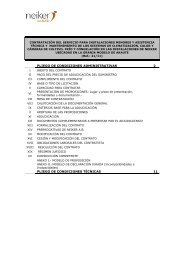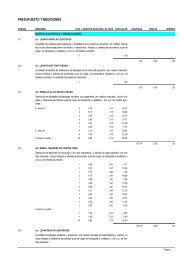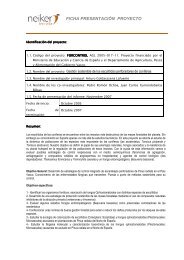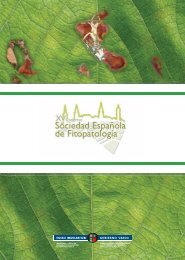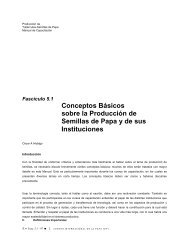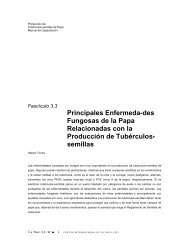The History of Potato (Solanum tuberosum L.) Research in ... - Neiker
The History of Potato (Solanum tuberosum L.) Research in ... - Neiker
The History of Potato (Solanum tuberosum L.) Research in ... - Neiker
Create successful ePaper yourself
Turn your PDF publications into a flip-book with our unique Google optimized e-Paper software.
20 <strong>Potato</strong> <strong>Research</strong> (2006) 49: 19–25<br />
situation the crop was <strong>in</strong> at that time, with low-yield<strong>in</strong>g, degenerate varieties,<br />
chronically <strong>in</strong>fected by viruses. <strong>The</strong> Station was a part <strong>of</strong> the BInstituto Nacional de<br />
Investigaciones Agronómicas^ (INIA, National Institute <strong>of</strong> Agronomic <strong>Research</strong>).<br />
Dur<strong>in</strong>g the early years, the work was ma<strong>in</strong>ly done at the Iturrieta farm, situated <strong>in</strong><br />
the mounta<strong>in</strong>s, at an altitude <strong>of</strong> 990 m. It was here where the regeneration and<br />
multiplication <strong>of</strong> Spanish varieties, the organisation <strong>of</strong> seed potato production and<br />
the importation <strong>of</strong> varieties from different European countries and studies on their<br />
adaptation started. Dur<strong>in</strong>g the next two decades, the first research on genetic<br />
breed<strong>in</strong>g was carried out and focused on four ma<strong>in</strong> selection criteria: yield, drought<br />
resistance, early maturity and frost resistance.<br />
First Period (1933–1950)<br />
In 1933, the regeneration and multiplication <strong>of</strong> Spanish varieties cultivated at that<br />
time started us<strong>in</strong>g apparently healthy material, with the objectives: high yield,<br />
drought resistance, early maturity and frost resistance. However, little success was<br />
achieved and the work was abandoned after only a few years, as the desired<br />
characteristics could not be identified among local varieties.<br />
At the same time, a seed potato production system was organised us<strong>in</strong>g clonal<br />
selection. <strong>The</strong> EMP produced certificated potato seed until 1941 when the BNational<br />
Seed <strong>Potato</strong> Service^ was segregated from it. <strong>The</strong> clonal selection cont<strong>in</strong>ued at EMP<br />
<strong>in</strong> order to obta<strong>in</strong> prebasic and basic material.<br />
Dur<strong>in</strong>g this time about 40 cultivars from <strong>The</strong> Netherlands, Germany, United<br />
K<strong>in</strong>gdom and USA were imported, and adaptation studies were carried out<br />
(Zubeldia and López-Campos, 1954; Ubillos, 1960). From <strong>The</strong> Netherlands the<br />
varieties Saskia and Robijn (Basabe) were studied. From Germany the cultivars,<br />
Allerfrüheste Gelbe (Palogán), Erntedank, Oberarnbacher Frühe (Santa Lucia),<br />
Ackersegen (Sergen) and Merkur (Alava) were imported and adapted and the<br />
variety Katahd<strong>in</strong> from the USA.<br />
Subsequently, and because <strong>of</strong> the Spanish civil war (1936–1939), the contribution<br />
<strong>of</strong> new national and foreign varieties stopped, until 1941 when new cultivars were<br />
imported from Germany. In this first period, genetic cross<strong>in</strong>g began and the first<br />
Spanish variety called BEm<strong>in</strong>encia^ was obta<strong>in</strong>ed, a high yield<strong>in</strong>g, early matur<strong>in</strong>g<br />
cultivar, which is now lost.<br />
Second Period (1950–1979)<br />
In the 1950s, the EMP cont<strong>in</strong>ued work<strong>in</strong>g at the Iturrieta farm to produce prebasic<br />
potato, while the rest <strong>of</strong> the activities were moved to the BGranja Modelo^ (Model<br />
Farm) situated <strong>in</strong> Arkaute, near Vitoria-Gasteiz (Alava), on a high pla<strong>in</strong> (the<br />
Llanada Alavesa) at 600 m altitude. In this second period, under the directorship <strong>of</strong><br />
Miguel Odriozola, the work was diversified and specialised, and the Station was<br />
divided <strong>in</strong>to four sections (Sánchez-Monge, 1988):<br />
– Virology, where the susceptibility <strong>of</strong> the varieties was studied, as well as<br />
symptomatology, transmission <strong>of</strong> the ma<strong>in</strong> viruses and detection techniques<br />
such as the callose test to detect the <strong>Potato</strong> leaf roll virus (PLRV) <strong>in</strong> the tuber.



